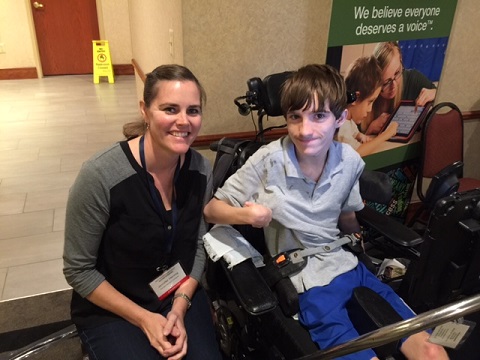
By Jennifer Herzog, B.S., Regional Consultant, Arkansas
It’s November. Time for turkey and trimmings, friends and family, and maybe football and all things fun!! It’s that time of year when we embrace all that we have to be thankful for, and this year is no exception for me. I have a ton of reasons to be thankful!
One of those was the opportunity I recently had to work the PRC booth at the Arkansas Speech and Hearing Conference with my two pals Bac Shelton and Kyle Robinson. Bac is a repeat year after year. Having previously lived in Arkansas for several years, he is a popular guy in this neck of the woods, and everyone loves to stop by the booth and chat with him. If he misses a year, I hear about it. “Where’s Bac this year?” “When is Bac coming back?” I mean, doesn’t anyone want to talk to me? Kyle joined us this year as a new PRC ambassador and a recent high school graduate. Both guys are very conversational on their devices: Bac using direct selection with his hands and Kyle direct selection with his eyes through the use of eye gaze. What I had not considered before inviting them both to work the conference was their love for the Dallas Cowboys. You see Bac now lives in Dallas, and it turns out Kyle is the biggest Cowboys’ fan EVER. Now don’t get me wrong, I LOVE football: love to watch it, love talk about it, attempt to play it, but I never imagined I’d be in the middle of a conversation at a speech and hearing conference involving the Dallas Cowboys, and, well, as you might expect, the Dallas Cowboy cheerleaders. What I should always expect with Bac and Kyle, however, is hours of entertainment!
 Jennifer and Kyle
Jennifer and Kyle
But it got me to thinking. How did these two people become conversational on their devices? What makes it so cool to sit back and listen to them carry on their conversations? For me it’s that I can’t, for a million years, imagine what they will say next! Looking back, both of them started with a robust, individual word vocabulary on their first AAC devices. With practice (and lots of it), they learned more and more words and were finally able to talk in sentences. Pair this with wanting to talk about things that interested them, and they had a reason to learn new words and use their devices! So, how can I help someone using an AAC device talk like Bac and Kyle?
Here’s where I ask for reader participation! Grab a piece of paper and a pen. Write down your favorite thing to do. Now, start talking to yourself about the activity and jot down the words you hear yourself saying. My guess would be that your activity may be a noun, but that you are probably using verbs, prepositions, interjections, adjectives, pronouns, etc…, to talk about that activity. Here’s what my list looks like:
Activity: Football Words I might say: I love football! I want to play. My turn. Will you play? My team is best! They are awesome! He threw it long! Look at him go! He got it! He is fast! He ran all the way! Get him! Stop him! Go, go, go!
Now identify these words on the device. Start with individual words first and use similar words, if you don’t have exact matches. Use tools like Vocabulary Builder to focus on specific vocabulary in teachable moments. Learn the words yourself so you can model them and be ready to respond when the individual says a word on the device. If we learn to talk about things that interest us, we are much more likely to use the device in other situations, and it’s even more likely the words we learn during these activities will translate to other situations. With more and more use of the device, we should start to see two and three word combinations as language development progresses.
Learning to talk with an AAC device should be fun! We need to give access to words the individual wants to say, offer many opportunities for practice, and keep the learning activities fun and engaging. Kyle and Bac continue to keep it fun, and I’m thankful for all the laughs and the conversation!
There are no comments yet. Be the first to post!You must be logged in to post.
Stories and Strategies fo...















